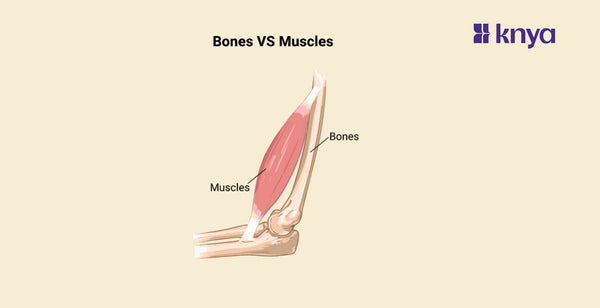Difference Between Bones and Muscles: Bones and muscles, though working together, have distinct roles in our body. Bones, forming the rigid framework or skeleton, provide structure and support, protecting organs and enabling movement at joints. In contrast, muscles are soft tissues that contract and relax to generate movement. This difference between bones and muscles is crucial for our body's ability to perform everyday activities.
Difference Between Bones and Muscles
Bones and muscles are vital components of the human body, collaborating to allow mobility, create structure, and support a variety of biological activities. Here are the differences between bones and muscles:
|
Aspect |
Bones |
Muscles |
|
Composition |
Hard, rigid; primarily calcium phosphate and collagen |
Soft tissues; bundles of muscle fibers, blood vessels |
|
Function |
Structural support, protection, attachment for muscles |
Generate force, movement by contracting and relaxing |
|
Types |
Long, short, flat, irregular bones |
Skeletal, smooth, cardiac muscles |
|
Mobility |
Relatively immobile individually, leverage for movement |
Highly mobile, contract to move bones and joints |
|
Blood Supply |
Rich blood supply for nutrient supply, repair |
Extensive network of blood vessels for oxygen supply |
|
Healing |
Self-repair through ossification process |
Partial regeneration after injury |
|
Growth |
Longitudinal growth at growth plates |
Increase in size (hypertrophy) with exercise |
|
Structure |
Complex internal structure with spongy, compact bone |
Bundles of muscle fibers surrounded by connective tissue |
|
Regulation |
Regulated by hormones such as PTH, calcitonin |
Regulated by nervous system, hormones like adrenaline |
|
Density |
Higher density compared to muscles |
Lower density, more flexible for movement |
Browse Best Scrubs Collection
What is Bones?
The skeleton, or framework of the body, is made up of bones, which are hard structures. They support, structure, and safeguard our organs. They also store minerals like calcium and phosphorus, which are essential for bone strength. The adult human body contains 206 bones, which vary in form and size.
Key Features of Bones:
- Bones are solid bones that give our bodies support, form, and protection. They are made up of live cells, collagen fibres, and minerals such as calcium and phosphate, which gives them their distinctive hardness.
- Bones occur in a wide range of forms and sizes, reflecting their many roles. Long bones, such as the femur, give support and leverage during movement, whereas flat bones, such as the ribs, protect important organs. Short bones, such as the carpals in the wrist, provide stability and flexibility.
- Bones unite at joints, providing for mobility and flexibility. The range and direction of movement are determined by the kind of joint used, such as hinge (elbow) or ball-and-socket (shoulder).
- Bones look immobile, although they are continually undergoing a dynamic process of remodelling. Old bone is broken down and replaced with new bone, which allows for stress adaptation and injury healing.
What are Muscles?
Muscles are the soft tissues that help us move. Tendons connect them to bones and cause them to contract, or shorten, pulling the bones together. Muscles are classified into three types: skeletal muscles, which are attached to bones and are responsible for voluntary movements; smooth muscles, which are found in the walls of organs and blood vessels and are responsible for involuntary movements; and cardiac muscle, which is located in the heart and is in charge of pumping blood.
Key Features of Muscles:
- Muscles are specialised tissues that contract and relax to generate the force required for movement. They are classified into three types: skeletal (connected to bones), smooth (found in organs), and cardiac (forming heart muscle).
- Myofibrils are long cylindrical fibres that make up muscles. These fibres include contractile proteins such as actin and myosin, which work together to create force when triggered by nerve impulses.
- Muscles are responsible for more than just movement; they also maintain posture, stabilise joints, and regulate organ function.
- Muscles may adapt to exercise and training, resulting in greater strength and endurance. They work in synchronised patterns to produce complicated actions that need precise nervous system control.
Shop Best Lab Coats from Here!
Similarities Between Bones and muscles
- Bones and muscles are essential for mobility, stability, and proper bodily function.
- They collaborate via the musculoskeletal system to provide coordinated movement.
- Both bones and muscles are living structures capable of adapting and changing in response to mechanical stress, exercise, and injury.
- Tendons link muscles and bones, allowing force to be transmitted during movement.
- Age-related changes, accidents, illnesses, and dietary imbalances can have an impact on bone and muscle health.
- They help the body's metabolism, regulate hormones, and store minerals.
- Both bones and muscles experience weariness, albeit through distinct methods.
- They go through repair and remodelling processes in response to mechanical stimuli and physiological needs.
While both bones and muscles are essential components of the musculoskeletal system, they have unique properties. Bones, which comprise the body's stiff skeleton, are made up of hard, calcified tissue that supports, structures, and protects organs. In contrast, muscles are soft structures made up of fibres that contract and relax to produce movement. This basic difference in composition emphasises the primary divergence between their functions: bones offer stability and structure, whilst muscles allow movement and maintain posture. Furthermore, bones are under automatic control, working continually to keep the body's form, whereas most muscles are under voluntary control, allowing for conscious movement.
| Check out More Articles | |
| Difference Between Cartilage and Bone | |
| Difference Between Endocrine and Exocrine Glands | |
| Difference Between Cell Wall and Cell Membrane | |















